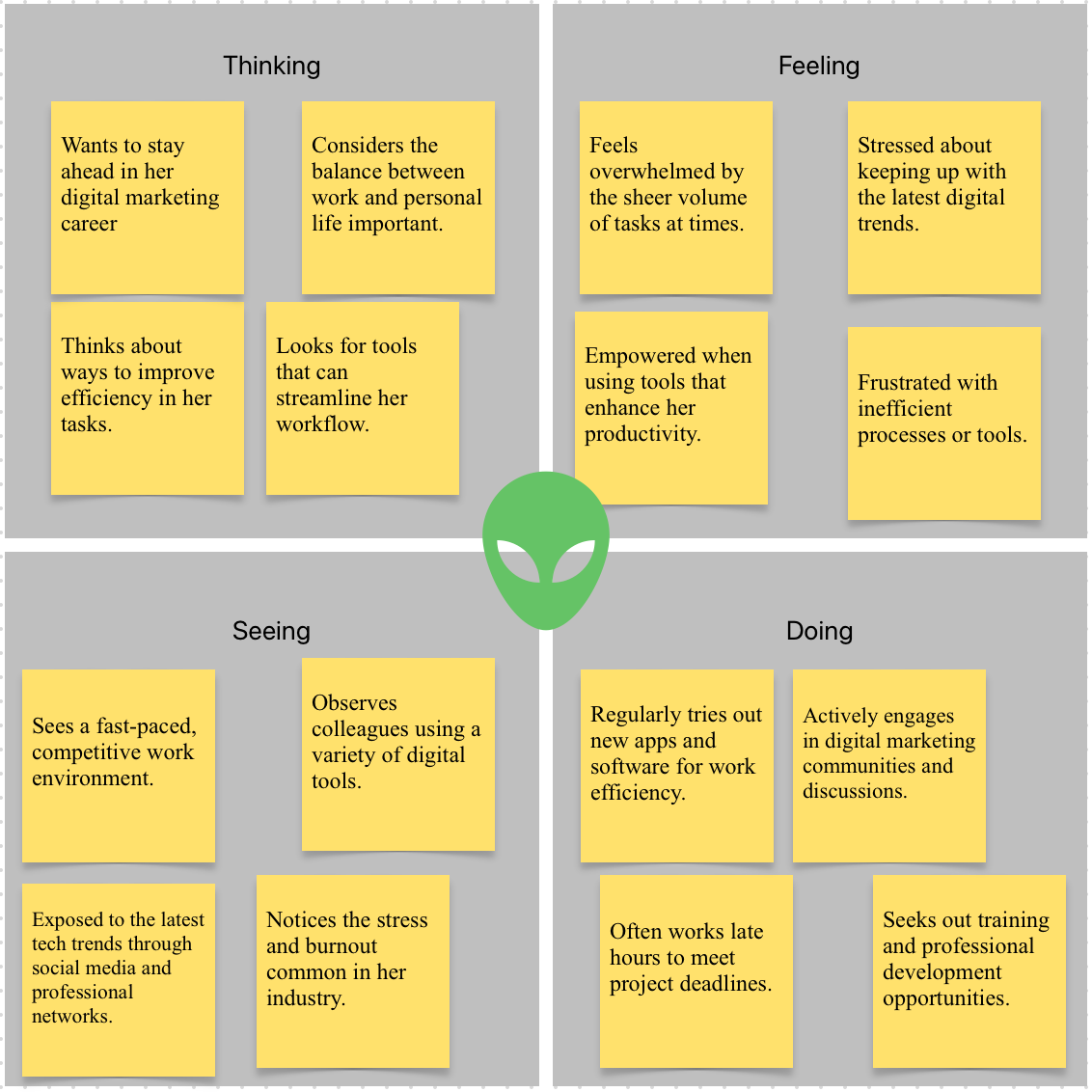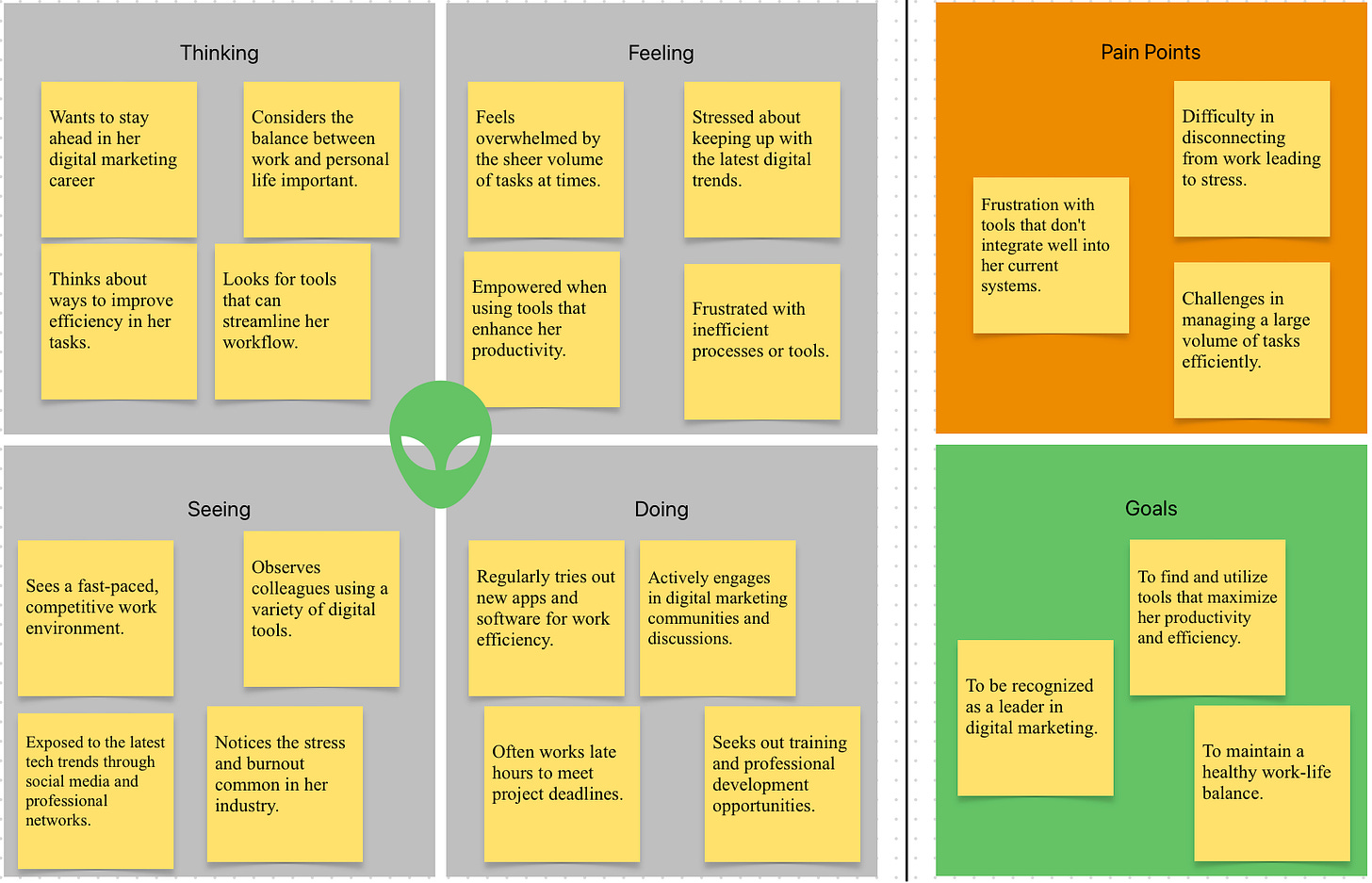Daily Exercise: Empathy Building
Develop a deeper understanding of various user personas, their needs, challenges, and motivations.
Good ‘Ol Personas
Ohhhh personas… I mostly love working with these. Personas involve crafting detailed, fictional characters that represent one or many key user groups for your product or service.
Personas should be realistic and specific, providing a clear picture of who the user is, their background, needs, and how you believe they might interact with your product or service.
But Charles… I don’t have a clear picture of this fictional… made up character.
Thats ok. Personas are made up to start, based on our “logical” opinions and thoughts. Over time you will iterate on these personas once you’ve collected enough data via user interviews and/or telemetry to be able to turn these fictional characters into more realistic ones. Think of your first few rounds of personas as hypotheses that you are wanting to test and refine.
Below you will find “Tina”, a tech-savvy persona. If you don’t like Tina, I understand… just use the template below to create your own.
Persona Example: "Tech-Savvy Tina"
Name: Tina Johnson
Age: 29
Occupation: Digital Marketing Specialist
Location: Urban, lives in a city apartment
Education: Bachelor's Degree in Marketing
Tech Proficiency: Very high; early adopter of new technology
Primary Device for Work: High-end laptop and smartphone
Background and Lifestyle:
Lives a fast-paced, connected lifestyle.
Values efficiency and productivity in both personal and professional life.
Socially active, with a strong presence on multiple digital platforms.
Goals and Motivations:
To excel in her career by staying ahead of digital trends.
To find tools and apps that streamline her daily tasks and personal organization.
To maintain a healthy work-life balance.
Challenges and Pain Points:
Often overwhelmed by the volume of tasks and information.
Needs tools that integrate seamlessly into her existing workflow.
Sometimes struggles to disconnect from work and manage stress.
Interaction with Your Product:
Likely to use your product for both work and personal organization.
Prefers solutions that offer customization and advanced features.
Values aesthetics and user experience in software.
Emotional Drivers:
Driven by a desire for career advancement and recognition.
Seeks products and services that make her feel empowered and in control.
**Media Consumption Habits:
Frequently uses social media, tech blogs, and podcasts to stay informed.
Engages with online communities related to her professional interests.
** These should be considered custom attributes that may be relevant to your product or service. Again… it is perfectly fine if you can’t think of anything right now. It’s just to get the creative juices flowing.
A Technique for Creating Personas
A fantastic and effective technique for getting those empathy juices flowing is the “Empathy Mapping” process. It’s a collaborative tool that you and/or your team can use to think about your customers.
A customer is ANYBODY who users your product. We like to create different types of customers using personas so that we can think about their more specific attributes.
Empathy mapping is simply a visual way to discuss what you may know about a specific type of user and helps to comprehend their needs, challenges, and goals.
Empathy Mapping Process
Gather User Data (If you have it… Otherwise skip):
For more mature product management teams, you may have data from previous surveys, interviews, analytics, social media comments, etc.
If you don’t have data yet, see if you can interview some of your customers to try and gather some data. Beware though… this isn’t as easy at it may seem.
Create the Empathy Map Canvas (Image above):
Draw a large square divided into four quadrants, with a user's head in the middle.
Label the quadrants as "Thinking," "Feeling," "Seeing," and "Doing."
Fill in the Quadrants:
Thinking: What are the user's thoughts and decision-making processes? What matters to them?
Feeling: What are the user's emotional responses? What worries or excites them?
Seeing: What does the user see in their environment? What are they exposed to in their daily life?
Doing: What actions does the user take? What behaviors do they exhibit?
There are no right or wrong answers here. Remember that this is an exercise to help you develop the muscle memory and recognize when you can potentially utilize these techniques.
🎉🎉🎉 The Exercise 🎉🎉🎉
Create Different User Personas (At least 3): Before you start, outline several user personas that you believe are relevant to your product, service or industry utilizing the technique above.
Write a Diary Entry: Every day for 10 business days, choose one of these personas and write a diary entry from their perspective. This entry should include:
A Description of Their Day: Focus on how they interact with products or services similar to yours.
Challenges and Frustrations: Highlight any difficulties they face, particularly those related to your product, service or industry.
Goals and Motivations: What are they trying to achieve, and what motivates them?
Emotional State: Reflect on how they might feel at various points in their day, especially when encountering problems.
Reflect: After writing the entry, take a moment to reflect on:
How this new perspective could influence your approach to product development.
Any new insights you gained about user needs and pain points.
Commit to at least 10 entries into a diary. Thats 1 per day for 10 business days. How else will you have the time for all of my other fun exercises in the future?!?!
Example of a Completed Empathy Map
Lastly, if you want an additional challenge… add pain points and goals to the empathy map as well.
Wow!!!! You made it to the end. Maybe you felt my content is engaging enough to subscribe 😅. Subscribing is free but if you want to comment and ask questions I’d like to ask that you become a paid subscriber. Regardless, thanks for reading! It means the world that you would consider my content as helpful while you are on the path to mastering the product management skillset.





